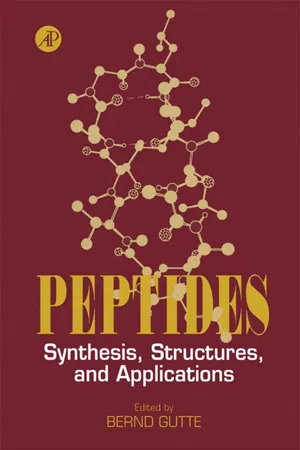
- 511 pages
- English
- ePUB (mobile friendly)
- Available on iOS & Android
About this book
In recent years, research has shown the importance of peptides in neuroscience, immunology, and cell biology. Active research programs worldwide are now engaged in developing peptide-based drugs and vaccines using modification of natural peptides and proteins, design of artificial peptides and peptide mimetics, and screening of peptide and phage libraries.In this comprehensive book, the authors discuss peptide synthesis and application within the context of their increasing importance to the pharmaceutical industry. Peptides: Synthesis, Structures, and Applications explores the broad growth of information in modern peptide synthetic methods and the structure-activity relationships of synthetic polypeptides.- The history of peptide chemistry- Amide formation, deprotection, and disulfide formation in peptide synthesis- Solid-phase peptide synthesis- a-helix formation by peptides in water- Stability and dynamics of peptide conformation- An overview of structure-function studies of peptide hormones- Neuropeptides: peptide and nonpeptide analogs- Reversible inhibitors of serine proteinases- Design of polypeptides- Current capabilities and future possibilities of soluble chemical combinatorial libraries- Epitope mapping with peptides- Synthesis and applications of branched peptides in immunological methods and vaccines
Frequently asked questions
- Essential is ideal for learners and professionals who enjoy exploring a wide range of subjects. Access the Essential Library with 800,000+ trusted titles and best-sellers across business, personal growth, and the humanities. Includes unlimited reading time and Standard Read Aloud voice.
- Complete: Perfect for advanced learners and researchers needing full, unrestricted access. Unlock 1.4M+ books across hundreds of subjects, including academic and specialized titles. The Complete Plan also includes advanced features like Premium Read Aloud and Research Assistant.
Please note we cannot support devices running on iOS 13 and Android 7 or earlier. Learn more about using the app.
Information
The History of Peptide Chemistry
I. Introduction
A. From Peptones to Peptides
B. The Structure of Proteins: Hofmeister–Fischer Theory
II. Early Peptide Syntheses
Table of contents
- Cover image
- Title page
- Table of Contents
- Copyright
- Contributors
- Preface
- Chapter 1: The History of Peptide Chemistry
- Chapter 2: Amide Formation, Deprotection, and Disulfide Formation in Peptide Synthesis
- Chapter 3: Solid-Phase Peptide Synthesis
- Chapter 4: α-Helix Formation by Peptides in Water
- Chapter 5: Peptide Conformation: Stability and Dynamics
- Chapter 6: Structure–Function Studies of Peptide Hormones: An Overview
- Chapter 7: Neuropeptides: Peptide and Nonpeptide Analogs
- Chapter 8: Reversible Inhibitors of Serine Proteinases: Naturally Occurring Miniproteins, Semisynthetic Variants, Recombinant Homologs, and Synthetic Peptides
- Chapter 9: Design of Polypeptides
- Chapter 10: Soluble Chemical Combinatorial Libraries: Current Capabilities and Future Possibilities
- Chapter 11: Epitope Mapping with Peptides
- Chapter 12: Synthesis and Applications of Branched Peptides in Immunological Methods and Vaccines
- Index